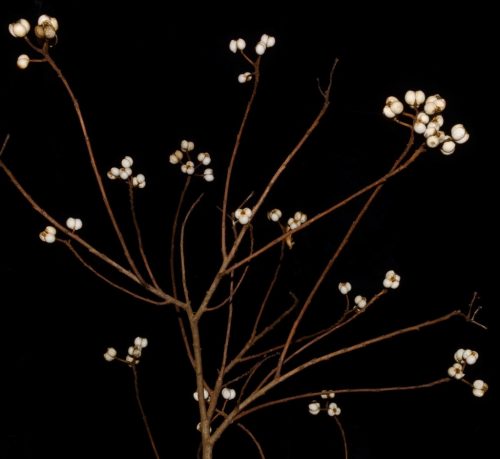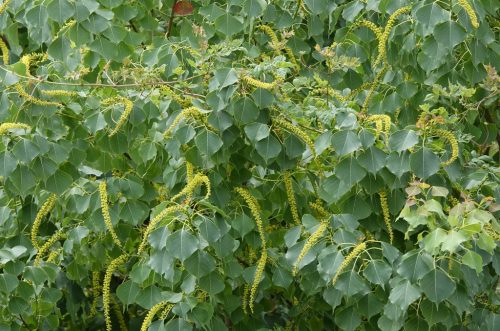What is happening?
 Chinese tallow, or the appropriately nicknamed “popcorn tree,” was introduced to the U.S. from China as an ornamental plant in the 18th century. With its beautiful, heart-shaped leaves that turn red as autumn comes around and its popcorn-like seeds, it’s not a surprise that the invasive Chinese tallow was brought to the U.S.
Chinese tallow, or the appropriately nicknamed “popcorn tree,” was introduced to the U.S. from China as an ornamental plant in the 18th century. With its beautiful, heart-shaped leaves that turn red as autumn comes around and its popcorn-like seeds, it’s not a surprise that the invasive Chinese tallow was brought to the U.S.
Unlike native trees, Chinese tallow is a fast-maturing species, has low predation from native insects, and offers almost no nutritional value for native wildlife. It also produces an abundance of seeds that are dispersed primarily via birds and water, and Florida has a lot of both. These characteristics make it an excellent invasive species capable of outcompeting native trees by forming dense clusters.
 Once established, Chinese tallow aggressively invades natural landscapes, particularly wetlands, floodplains, and coastal prairies, where it replaces native vegetation. The tree alters soil chemistry by increasing its nitrogen content, which can give it a competitive advantage over native plants that are adapted to low-nutrient conditions. This results in changes to the distribution of plant species in an ecosystem, often reducing biodiversity.
Once established, Chinese tallow aggressively invades natural landscapes, particularly wetlands, floodplains, and coastal prairies, where it replaces native vegetation. The tree alters soil chemistry by increasing its nitrogen content, which can give it a competitive advantage over native plants that are adapted to low-nutrient conditions. This results in changes to the distribution of plant species in an ecosystem, often reducing biodiversity.
Additionally, Chinese tallow produces chemical compounds that can suppress the germination and growth of other plant species, a phenomenon known as allelopathy. This further contributes to its ability to dominate ecosystems and push out native species.
Removing this plant is no small feat either because it often grows back from the stump or from seeds that remain unnoticed in the area. Mature trees produce thousands of seeds annually, and their rapid germination and growth rate make eradication efforts labor-intensive and costly. Even after removal, the tree can become re-established when seeds hidden beneath the soil sprout new growth, requiring ongoing management efforts.
Why it matters
Florida is a hotspot for invasive species, and Chinese tallow is one of the hardiest and most rapidly spreading. Its presence in natural areas threatens biodiversity and disrupts native ecosystems in several ways:
 Habitats and ecosystems: Chinese tallow thrives in a variety of environments, including wetlands, floodplains, coastal prairies, and disturbed urban areas. It aggressively displaces native vegetation and alters soil composition, reducing habitat quality for native wildlife.
Habitats and ecosystems: Chinese tallow thrives in a variety of environments, including wetlands, floodplains, coastal prairies, and disturbed urban areas. It aggressively displaces native vegetation and alters soil composition, reducing habitat quality for native wildlife.
- Impact on native flora and fauna: The tree’s rapid growth and ability to form dense clusters prevent native plants from establishing, leading to a decline in plant diversity. Its leaves contain toxic compounds that deter herbivory by native insects and wildlife, further disrupting food webs.
- Fire and water disruption: Chinese tallow changes the fire dynamics of ecosystems by increasing fuel loads, which can lead to hotter, more destructive wildfires. Additionally, the shade it produces prevents native wetland plants from growing. It also changes how the soil holds water.
What you can do
The establishment of Chinese tallow by people is prohibited in Florida, but that does not stop it from growing and spreading. Fortunately, there are steps you can take to manage and prevent its spread:
 Identification and removal: If you have Chinese tallow on your property, removing it properly is key. Cutting alone is ineffective as the tree will resprout. Instead, apply an appropriate herbicide to the cut stump to prevent regrowth.
Identification and removal: If you have Chinese tallow on your property, removing it properly is key. Cutting alone is ineffective as the tree will resprout. Instead, apply an appropriate herbicide to the cut stump to prevent regrowth.
- Proper disposal: Do not leave removed trees or seeds on the ground where they can be carried away by wind or water. Dispose of them according to local guidelines for invasive plant material.
- Encourage native alternatives: Native trees like slash pine (Pinus elliottii) and sweetgum (Liquidambar styraciflua) can outcompete Chinese tallow when given the opportunity to establish. Planting these species in areas previously invaded by Chinese tallow helps restore native ecosystems.
- Spread awareness: Educate your community about the dangers of Chinese tallow and advocate for the removal of existing trees in local parks and natural areas.
By taking these steps, we can slow the spread of Chinese tallow and protect Florida’s diverse ecosystems from further degradation.
Information from UF/IFAS, Florida Fish and Wildlife Conservation Commission, and the Florida Native Plant Society. Images from Canva, jmole (CC BY-NC), jrichardabbott (CC BY-NC), and MayMurphy (CC BY-NC).